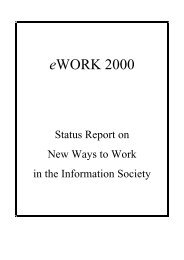Proceedings of 8th European Assembly on telework (Telework2001)
Proceedings of 8th European Assembly on telework (Telework2001)
Proceedings of 8th European Assembly on telework (Telework2001)
Create successful ePaper yourself
Turn your PDF publications into a flip-book with our unique Google optimized e-Paper software.
53Table 3:Indicators for measuring adaptability <str<strong>on</strong>g>of</str<strong>on</strong>g> work arrangementsDimensi<strong>on</strong> Indicator Definiti<strong>on</strong> Year SourceTimeTimeVoluntary parttimeworkingTemporalaut<strong>on</strong>omy in jobVoluntary part-time workers in %<str<strong>on</strong>g>of</str<strong>on</strong>g> total labour force% <str<strong>on</strong>g>of</str<strong>on</strong>g> total labour force withdiscreti<strong>on</strong> over start/fi nish <str<strong>on</strong>g>of</str<strong>on</strong>g>working timePlace Teleworking All <strong>telework</strong>ers in % <str<strong>on</strong>g>of</str<strong>on</strong>g> labourforcePlace Tele-cooperati<strong>on</strong> Workers who tele-cooperate as% <str<strong>on</strong>g>of</str<strong>on</strong>g> all workersC<strong>on</strong>tractC<strong>on</strong>tractAppliedskillsAppliedskillsIncrease in selfemploymentEmploymentprotecti<strong>on</strong>legislati<strong>on</strong>Managerialresp<strong>on</strong>sibilityLifel<strong>on</strong>g learning<str<strong>on</strong>g>of</str<strong>on</strong>g> employeesIncrease in the share <str<strong>on</strong>g>of</str<strong>on</strong>g>self-employed in % <str<strong>on</strong>g>of</str<strong>on</strong>g> totalemployment 1989-1999Employment Protecti<strong>on</strong>Legislati<strong>on</strong> Indicator by OECDWorkers with managerialresp<strong>on</strong>sibility in work in % <str<strong>on</strong>g>of</str<strong>on</strong>g>total labour forcePercentage <str<strong>on</strong>g>of</str<strong>on</strong>g> employees, aged30-39, who have participated intraining over the 4 weeks prior tothe survey.1999 Eurostat (LFS)1999 Empirica ECaTT1999 Empirica ECaTT1999 Empirica ECaTT1988/19981998 OECDEurostat (LFS); IAB1999 Empirica ECaTT1999 Eurostat (LFS)We are aware <str<strong>on</strong>g>of</str<strong>on</strong>g> the limitati<strong>on</strong>s <str<strong>on</strong>g>of</str<strong>on</strong>g> some <str<strong>on</strong>g>of</str<strong>on</strong>g> these indicators for our purpose (to be discussed inthe following); n<strong>on</strong>etheless, we have undertaken this effort to dem<strong>on</strong>strate an approach which mayc<strong>on</strong>stitute a starting point when trying to use as many easily available data from <str<strong>on</strong>g>of</str<strong>on</strong>g>ficial statisticalsources for this purpose. Research projects for developing more appropriate indicators andmethodologies for gathering the associated data are needed. The SIBIS project (IST-2000-26276SIBIS Statistical Indicators Benchmarking the Informati<strong>on</strong> Society: www.sibis-eu.org), in whichthe authors are involved, is an attempt by the <str<strong>on</strong>g>European</str<strong>on</strong>g> Commissi<strong>on</strong> to cover deficits in this areaand will deliver results in 2002.Part-time working describes the fact that workers can choose between either <strong>on</strong>e or a limitednumber <str<strong>on</strong>g>of</str<strong>on</strong>g> part-time working models (e.g. 19 hours per week). In certain cases employers <str<strong>on</strong>g>of</str<strong>on</strong>g>fergreater flexibility to chose any model preferred as l<strong>on</strong>g as business requirements are met. The hoursworked may originate in preferences <str<strong>on</strong>g>of</str<strong>on</strong>g> the worker, the company, or both depending <strong>on</strong> the overalllabour market situati<strong>on</strong> (e.g. unemployment rates) and business imperatives. The rise in part-timework in many countries appears to be the outcome <str<strong>on</strong>g>of</str<strong>on</strong>g> increases in labour market participati<strong>on</strong> andgrowing lifestyle opti<strong>on</strong>s, and sometimes a lack <str<strong>on</strong>g>of</str<strong>on</strong>g> full-time employment [8]. Government suchas in the Netherlands have developed a strategy <str<strong>on</strong>g>of</str<strong>on</strong>g> promoting part-time working with the attemptto reduce unemployment rates and <str<strong>on</strong>g>of</str<strong>on</strong>g>fer work opportunities to those not able to work full-time(especially women). High levels <str<strong>on</strong>g>of</str<strong>on</strong>g> part-time work, however, are not necessarily a sign <str<strong>on</strong>g>of</str<strong>on</strong>g> labour








